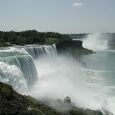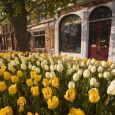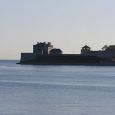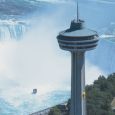Niagara
Advertisement
By Air
Fly to either Buffalo NY's Buffalo/Niagara Intl. which is 25 miles/41 kilometers to the Falls or Toronto Canada's Lester Pearson Intl. which is 78 miles/125 kilometers. The airport you choose to arrive at usually depends on where you are coming from. Toronto serves many international flights while Buffalo serves only U.S. domestic travel
By Train
Train service is available to Niagara Falls Canada on VIA Rail and Go Transit or to Niagara Falls NY on AMTRAK.
By Car
Using your favorite mapping software try 1 Prospect Point in Niagara Falls NY or 1 Falls Ave for Niagara Falls Ontario Canada.
By Bus
The bus terminal in Niagara Falls Canada (Niagara Falls Transit) is at 4555 Erie Avenue. Tel:(905)357-2133. It's 3.3Km (2miles) from the bus terminal to the Horseshoe Falls. There is a paid seasonal shuttle to the Falls which runs from mid May to Mid October. During the winter months you have to either walk or take a taxi to your destination
Advertisement
Niagara Falls
The Niagara Falls are in the extreme south of the province of Ontario where the waters of Lake Erie plummet down almost 60 m (197 ft) into Lake Ontario below. Niagara Falls are amongst the largest, most beautiful and certainly most famous waterfalls in the world. They were first chronicled in 1678 by Jesuit missionary Louis Hennepin, who followed the sound of the rushing waters upstream along Lake Ontario to discover this great body of falling water, nowadays seen by over 12 million visitors a year.
The falls are in two parts, the concave Horseshoe Falls, 640 m (2100 ft) across, which are Canadian, and in the Province of Ontario, and the American Falls, about 330 m (1083 ft) across, in the State of New York, so the national boundary between Canada and the States runs through the middle.
Before the waters were used for hydro-electric power almost six million liters of water a second hurtled over the rocky rim. A Canadian/American agreement in 1951 for joint use guaranteed close on 3 million liters a second in summer and 1.4 million in winter. The spray rising from the foaming cauldron at the foot of the falls has beautiful rainbows when the sun shines.
Below the falls the Niagara River flows through the deep walls of the gorge, between 80 and 300 m (263 and 985 ft) across, forming the Whirlpool Rapids as the gorge narrows to the north-west.
Just 6 km (4 mi.) below the Horseshoe Falls the river changes course and turns north-east, and at that point swirls around in another seething cauldron, this time known as the Whirlpool, before plunging down through the Lower Rapids into Lake Ontario.
Niagara-on-the-Lake
Niagara-on-the-Lake (pop.13,839) is a delightful small picture-book town at the northern end of the falls and on the shores of Lake Ontario. The first capital of Upper Canada, it was razed to the ground by American troops during the War of 1812 against the British, but rebuilt with all due speed.
The town is full of pretty 19th C houses set in their lovely gardens. Queen Street, its main street, has a clock tower in the middle and many little boutiques, eating places and hotels. The Niagara Apothecary, built in 1866, is especially quaint.
The little town has three theatres and is especially famous for its annual George Bernard Shaw Festival.
During the summer months Niagara-on-the-Lake is very busy with tourists from all over the world.
Fort George National Historic Site
Fort George dates from the end of the 18th C and was erected here to protect the area against attack by the Americans in their revolt against the British. The Commander at that time was Major General Isaac Brock. During the skirmishing of the War of 1812/1813 the fort fell into the hands of the Americans who took it under fire from the lake. Abandoned in 1820, the fort was declared a National Historic Park in 1969 and has since been lovingly restored, with visitors flocking here every year to learn more about the history of the area. At the height of the tourist season there are enactments of the military drills, firing practice and cookhouse activities of the early 19th C.
Skylon Tower
The Skylon Tower is Niagara Falls' most visited attraction and with good reason. At a heigh of 520 ft / 160 m, visitors to the Skylon Tower are rewarded with a 360 degree view of Niagara Falls and the surrounding countryside. The view encompasses the Niagara Escarpment, which Niagara Falls tumbles over, and shows the general lay of the land.
The Skylon Tower is a great place to start your visit to Niagara Falls. From this sky high view point you can plan out your route and see the major attractions such as Clifton Hill. The Skylon Tower is well set up for those wanting to stop for lunch or dinner. The Skylon tower features two revolving restaurants, one upscale, the other more of a mid range establishment.
Information not available
January - February -> -26(°C) - Winter
July - August -> 22(°C) - Summer
Advertisement







